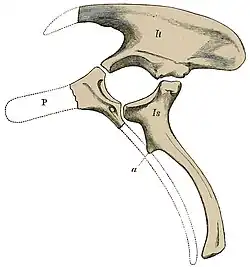バリリウム
バリリウム (Barilium) は、イグアノドン類の恐竜の属の一つ。
| バリリウム | ||||||||||||||||||||||||||||||||||||
|---|---|---|---|---|---|---|---|---|---|---|---|---|---|---|---|---|---|---|---|---|---|---|---|---|---|---|---|---|---|---|---|---|---|---|---|---|
 バリリウムの骨盤 | ||||||||||||||||||||||||||||||||||||
| 地質時代 | ||||||||||||||||||||||||||||||||||||
| 中生代白亜紀前期 (約1億2,600万 ~ 1億2,500万年前) | ||||||||||||||||||||||||||||||||||||
| 分類 | ||||||||||||||||||||||||||||||||||||
| ||||||||||||||||||||||||||||||||||||
| 学名 | ||||||||||||||||||||||||||||||||||||
| Barilium Norman, 2010 | ||||||||||||||||||||||||||||||||||||
| シノニム | ||||||||||||||||||||||||||||||||||||
| ||||||||||||||||||||||||||||||||||||
| 種 | ||||||||||||||||||||||||||||||||||||
元々はリチャード・ライデッカーによってイグアノドン (I. dawsoni) として1888年に記載されていた。模式種B. dawsoni1種のみで知られる。模式種の種小名は、発見者であるチャールズ・ドーソンへの献名による[1]。
概要

中部胴椎
2010年にデビッド・ノーマンによる再分類で新属として独立した。属名は古代ギリシャ語で「重い腸骨」を意味する[2]。同年、ケネス・カーペンターと石田雄介によって新属トリリオン (Torilion)[3] が記載されたが、バリリウムの新参同物異名となった。イングランドのイーストサセックスにある St Leonards on sea 近郊で発見された2つの部分骨格で知られる[4]。白亜紀前期、バランギニアン中期の泥岩層で発見された[5]。ライデッカーはシンタイプシリーズ BMNH R798, 798a, 803-805, 806, 798b, 802, 802a and 799-801 に基づいて記載した。ノーマンは胴椎NHMUK R 798 と左腸骨 R802 をレクトタイプに選んだ。
ヒプセロスピヌス(同じく、かつてはイグアノドンと考えられていた)と共存していたバリリウムは、全長8mと推定される堅牢なイグアノドン類だった[6]。
バリリウムは脊椎と坐骨の特徴、サイズ、そして構造からヒプセロスピヌスと区別される[6]。例えば、バリリウムはヒプセロスピヌスよりも堅牢で、短い神経棘を特徴とする大きなカンプトサウルスに似た椎骨があるが、ヒプセロスピヌスは「長く、狭く、鋭角に傾斜した神経棘」で知られている[7]。
脚注
- Lydekker, Richard (1888). “Note on a new Wealden iguanodont and other dinosaurs”. Quarterly Journal of the Geological Society of London 44 (1–4): 46–61. doi:10.1144/GSL.JGS.1888.044.01-04.08.
- Norman, David B. (2010). “A taxonomy of iguanodontians (Dinosauria: Ornithopoda) from the lower Wealden Group (Cretaceous: Valanginian) of southern England”. Zootaxa 2489: 47–66. doi:10.11646/zootaxa.2489.1.3.
- Carpenter, K. and Ishida, Y. (2010). "Early and “Middle” Cretaceous Iguanodonts in Time and Space." Journal of Iberian Geology, 36 (2): 145-164.
- Norman, David B. (2004). “Basal Iguanodontia”. In Weishampel, D.B.. The Dinosauria (2nd ed.). Berkeley: University of California Press. pp. 413–437. ISBN 978-0-520-24209-8
- Paul, Gregory S. (2008). “A revised taxonomy of the iguanodont dinosaur genera and species”. Cretaceous Research 29 (2): 192–216. doi:10.1016/j.cretres.2007.04.009.
- Blows, W. T. (1997). “A review of Lower and middle Cretaceous dinosaurs from England”. In Lucas, S.G.. Lower and Middle Cretaceous Terrestrial Ecosystems. New Mexico Museum of Natural History and Science Bulletin, 14. New Mexico Museum of Natural History and Science. pp. 29–38
- Naish, Darren; Martill, David M. (2008). “Dinosaurs of Great Britain and the role of the Geological Society of London in their discovery: Ornithischia”. Journal of the Geological Society, London 165 (3): 613–623. doi:10.1144/0016-76492007-154.
This article is issued from Wikipedia. The text is licensed under Creative Commons - Attribution - Sharealike. Additional terms may apply for the media files.